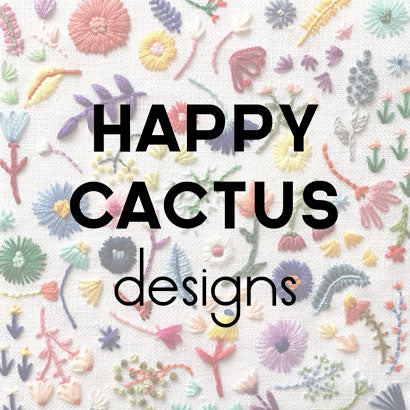September 16, 2019
I've blogged about the best embroidery hoops and fabric, but one of my most frequently asked questions over on Instagram is how I organize my embroidery threads.

Keeping my threads organized is so essential to making stitching easier. I primarily work with DMC six strand cotton floss. This type of floss is typically sold in skeins. A skein is a loose coil of thread and has two label tabs on either end. DMC gives each color its own identifying number.
When I first started, I never undid the coil; I just pulled the thread. Big mistake! Over time, these coils get knotted, twisted, and/or impossible to keep track up.
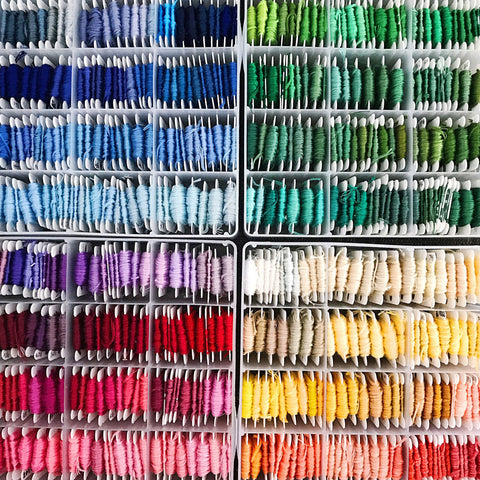
A peek at my thread boxes.
So what to do? I finally got smart and ordered plastic bobbins and divided thread storage boxes. They are game changers!
In my new guide, Hand Embroidery Essentials, I share direct links to where I source these supplies as well as my methods for winding bobbins and organizing the colors. In addition to these tips, I go in depth about different types of embroidery thread and where to buy them, what to do with leftover threads, and what to do if your thread color bleeds. Find the guide here!
Want to be the first to hear about Happy Cactus Designs' latest products and promotions? Sign up for our newsletter here.
August 26, 2019
In my previous blog post, I wrote about the best fabrics for hand embroidery. In this post, I wanted to touch on another embroidery essential - the hoop.
There are many different types of hoops out there, and I’ve about tried them all! From pricier imported wood hoops to plastic hoops to "hoops" made of plastic piping, there are a lot of varieties to try out. Sometimes it comes down to personal preference depending on what feels good in your hands and what materials you choose for your stitching projects.
Using a hoop makes stitching much easier as your hands have something to hold. It also keeps your fabric taut, which helps you to stitch evenly and to prevent your fabric from puckering.
The size of hoop you select completely depends on the size of the embroidery you are hoping to stitch. I typically work with hoops in the range of 5 to 7 inches wide.
In my new guide, Hand Embroidery Essentials, I do a deep dive into hoops and go into great detail about how to use a hoop, the various brands I've tried, and what I prefer to use. You can find the guide here.
Want to be the first to hear about Happy Cactus Designs' latest products and promotions? Sign up for our newsletter here.
August 19, 2019
What fabric do you stitch on? Where do you buy your fabric? These are two of the most common questions I receive on Instagram about my work.
Different types of fabric for hand embroidery.
It's taken a lot of trial and error to figure out the fabric I prefer to stitch on. These days I typically work on fine imported linen, but I learned how to stitch on different types of cotton. I mention trial and error because fabric quality varies a LOT and over time I've learned how much easier it is to stitch on quality materials. This often translates to the fabric being more expensive, but I choose to invest in the best materials I can find because I want my work to have an heirloom quality that will last for years and years.
If you want to learn more about fabric, I go in depth about how I select fabrics, the pros and cons of different types, the materials to avoid, and the exact places I purchase fabric in my new digital guide, Hand Embroidery Essentials. You can find it in my shop here!
Want to be the first to hear about Happy Cactus Designs' latest products and promotions? Sign up for our newsletter here.
July 30, 2019
After you have purchased Hand Embroidery Essentials, there are 3 ways to download the guide, ensuring you won't have a hard time figuring out how to download it.
1) After placing your order, there will be a link to directly download the guide on the final order confirmation page. Under your order number at the top of the page, you'll see a link that says "Click here to download the digital hand embroidery essentials guide."
2) You'll find a link to download the guide at the bottom of your order confirmation email. This email is sent from "Happy Cactus Designs" with the email address hello@happycactusdesigns.com.
3) You will also receive a second email soon after you place your order with a link to download the guide to your computer or other device. Please note that this is a separate email from your order confirmation email and will come from "Happy Cactus Designs" with the email address noreply@sendowl.com. SendOwl is the app used to deliver your digital download. Please check your spam folder if you don't see these emails.
A few notes about the download:
You may download the guide three separate times.
The PDF file size is approximately 21 MB.
Please check your spam folder if you don't see this email. Alternatively, some email carriers have a separate "promotions" folder these emails may be sent to.
The guide is a PDF, so you will need a PDF reader (such as Adobe Acrobat) to open and view the guide. Download one here.
If you have problems with your download, contact hello{at}happycactusdesigns.com.
Want to be the first to hear about Happy Cactus Designs' latest products and promotions? Sign up for our newsletter here.
November 28, 2016
Looking to spruce up your embroidery stash? I've pulled together a rundown of my favorite hand embroidery products that may be something you'd like to find under the Christmas tree, too. Share this URL with those asking what's on your gift list and hope you end up happy!
My Favorite Fancy (and Very Sharp) Embroidery Scissors
Studio Carta Crane Scissors // Gingher Design Series Scissors
DMC Cotton Floss Packs - the more skeins, the merrier!
DMC Embroidery Home Decor Floss Pack // Popular Colors Floss Pack
A High Quality Floor Lamp - not the fanciest gift, but sometimes practical is best!
Lavish Home Sunlight Floor Lamp
Top Notch Hand Embroidery Books to Teach Yourself - never stop learning!
Mary Thomas's Dictionary of Embroidery Stitches // The Stitch Bible by Kate Haxell
Pouches to Hold Your Embroidery Tools - I have a serious pouch addiction. I can never have too many! Perfect for traveling with your embroidery.
Baggu Leather Stash Pouch (in Copper) // Loeffler Randall Pouch
Madewell Leather Pouch // Truffle Clarity Clutch
Want more of my hand embroidery tips? You can find them here.
Want to be the first to hear about Happy Cactus Designs' latest products and promotions? Sign up for our newsletter here.
September 09, 2016
As I've shared before, I taught myself hand embroidery when I was laid up on the couch following an ankle injury. I really enjoyed watching YouTube videos because I could easily see how to create particular stitches. That said, I also relied on a number of wonderful embroidery books that I still reference today.
These are my favorite books that are "stitch dictionaries" and cover everything from a basic running stitch to incredibly complex stitches. They are chock full of photographs and diagrams that help you practice. It's also worth noting that a number of these books also cover cross stitch.
The Stitch Bible: A Comprehensive Guide to 225 Embroidery Stitches and Techniques by Kate Haxell
Mary Thomas's Dictionary of Embroidery Stitches by Mary Thomas
Embroidery: A Step-By-Step Guide to More than 200 Stitches by Lucinda Ganderton
Embroidery Pocket Guide by Leisure Arts (this isn't a book, but a handy little laminated guide)
Rebecca Ringquist's Embroidery Workshops: A Bend-the-Rules Primer by Rebecca Ringquist
Want more of my hand embroidery tips? You can find them here.
Want to be the first to hear about Happy Cactus Designs' latest products and promotions? Sign up for our newsletter here.
August 04, 2016
I launched my first collection of hand embroidery for sale almost a year ago. As my work has reached new audiences and demand for my artwork has increased, I've also spent many more hours of my day stitching than I had in the past. And let me tell you, stitching for hours on end can be very hard on your body! So in this post I wanted to address a few self care tips that I practice to ensure I'm still able to get up every day and stitch.
Use a timer.
When I am deep into a project, I can stitch for hours and hours without getting up. While this is great for making progress on a piece, it's horrible for my body and hands! So I use a timer that reminds me when I need to get up and stretch, switch tasks for awhile, or just take a general break. Granted, sometimes I just turn the timer's alarm off and keep stitching, but I'm trying to get better about actually stopping what I'm doing and take a moment. Moving the timer to a different part of my studio or even the hallway helps ensure I actually get up and move.
This cube is my favorite timer. I just flip the cube to whatever time increment I want.
Awareness of body and posture.
I really try to pay attention to my body and posture while I'm stitching. How is my neck positioned? Is my back hurting? Am I leaning awkwardly? I keep a little post-it note on the wall across from where I stitch that reminds me to check my position every so often. I sit on an awesome Aeron chair that has great lumbar support and adjust the height of the chair so it meets my stitching table perfectly.
Wear special gloves for hands.
From time to time, my hands can grow fatigued from stitching, especially if I am doing very detailed work like filing in a flower. I purchased these gloves awhile back and really feel like they make a difference. They are made of a stretchy spandex that slightly compresses your hand and eases the fatigue that can come from the repetitive nature of stitching. I don't wear them all of the time, but try to remember to put them on when I am working on a large project or if my hands start feeling tired.
Use a good light.
Another key component to my stitching setup is this sunlight lamp. The light emulates natural sunlight - it's a soft, white light versus the standard yellowish light bulb. It eases any eye strain and helps me see my hoop and stitching very clearly.
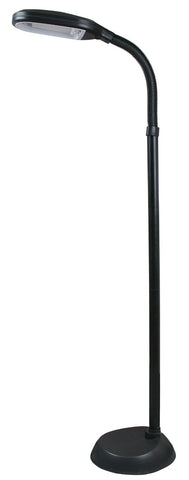
Lavish Home Sunlight Floor Lamp
See professionals as needed.
I have a mini squad of healthcare professionals that I see regularly - an acupuncturist, a chiropractor, and a massage therapist - that help me stay feeling good. I don't know what I would do without them! I'm only able to stitch and continue to do what I love if I feel good, so I definitely prioritize visiting professionals that can work with me so I'm at my best.
Want more of my hand embroidery tips? You can find them here.
Want to be the first to hear about Happy Cactus Designs' latest products and promotions? Sign up for our newsletter here.
May 27, 2016
I write this blog post as I look at my studio desk, littered with thread, scissors, and a handful of works in progress on hoops. Selecting a hoop for your hand embroidery project is no great mystery, but I thought I'd share some bits of advice about the types of hoops I use.
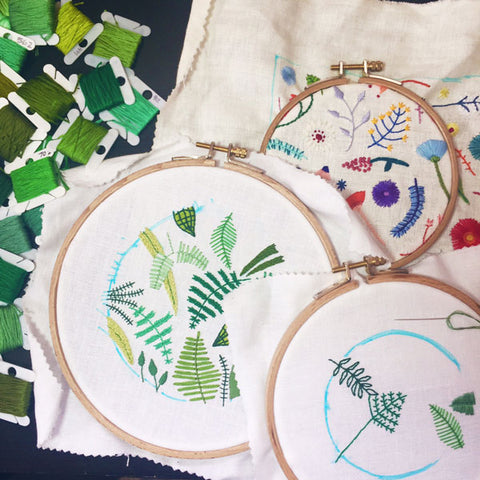
I prefer wooden hoops to plastic hoops. And I prefer well made wooden hoops to inexpensive ones. Now, when it comes to wood versus plastic, that may be a personal preference. I find that wood is gentler on the linen fabric I embroider on. With my wooden hoops, I also wrap the inner hoop with cotton twill tape. This helps to minimize the impact of the linen being bound inside the hoop and better protects my stitches as I work. You can do a simple Google search to find some good tutorials for wrapping a hope with tape.
Hardwicke Manor wooden hoops are my favorite. These are German birch hoops with brass hardware. Put them side by side a wood hoop from your local craft shop and you can immediately tell the difference. Hardwicke Manor hoops are stronger, sturdier, and better made.
I recently purchased a Morgan lap stand hoop and have experimented with it a bit. I was looking for a way to lighten the load on my shoulder. It can get sore and tired from holding the hoop. So far, it's been tricky to adjust to using since I still have to flip the hoop back and forth. We'll see.
I've also looked into different types of stands and have bought some Evertite stretcher bar frames that I've yet to put together and experiment with. I will report back any findings here!
Want more of my hand embroidery tips? You can find them here.
Want to be the first to hear about Happy Cactus Designs' latest products and promotions? Sign up for our newsletter here.
May 09, 2016
When asked about the hand embroidery process, these words always come to mind: slow, meditative, fun, tedious, enjoyable, calming, tiring, invigorating. Clearly, it can be a study in opposites!
Hand embroidery is also a test of my patience. A piece doesn't just take form in a matter of minutes or even hours. It happens over days and weeks. I don't really plan out most pieces ahead of time, so I never really know how long something is going to take. I sometimes track my time from the first stitch to the last stitch, but this can get a bit laborious.
I posted this photo on Instagram recently to demonstrate how slow and methodical the process is for me.
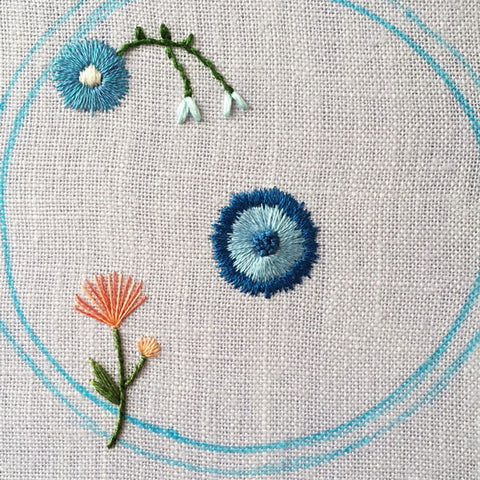
The three flowers above took about one and a half hours to complete, and most of the work was stitched with a single strand of thread (from a skein of six strands). Each flower is about an inch to an inch and a half.
Hand embroidery has also taught me a lot about listening to my own body. The process can actually be quite physically grueling - there is a lot of leaning, neck strain, and an intense use of both hands and arms (one hand for stitching, one hand for firmly holding the hoop still). At the same time, I'm focusing my eyes on the exact point of stitching. I've become better about taking breaks, stretching, noticing and correcting my posture, and switching tasks, plus I see an acupuncturist, chiropractor, and a massage therapist regularly (it takes a village!).
All of this is to say, when you buy a piece of hand embroidered artwork from me, a lot of love, patience, and time went into each and every piece. It's a process I love more than anything. Through embroidery, I've been able to push myself creatively in ways I didn't know were possible, and I hope that comes through in my work.
Want more of my hand embroidery tips? You can find them here.
Want to be the first to hear about Happy Cactus Designs' latest products and promotions? Sign up for our newsletter here.
